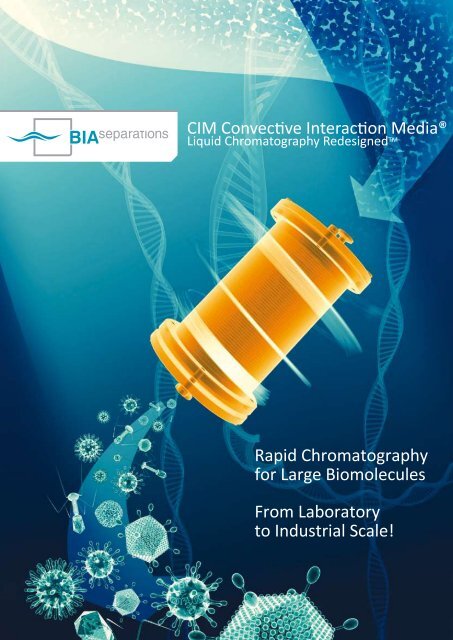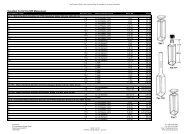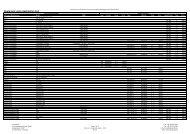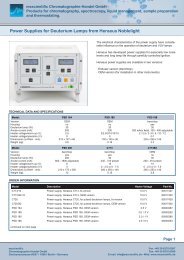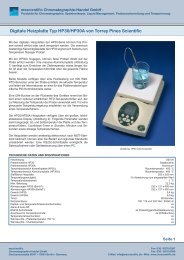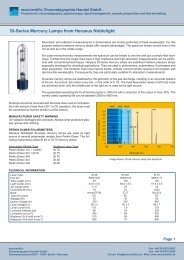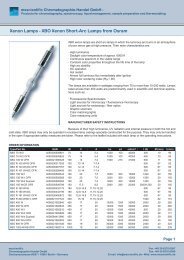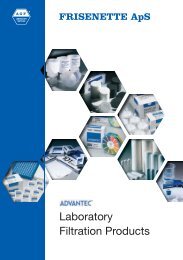CIM Convective Interaction Media Monolithic Columns
CIM Convective Interaction Media Monolithic Columns
CIM Convective Interaction Media Monolithic Columns
- No tags were found...
Create successful ePaper yourself
Turn your PDF publications into a flip-book with our unique Google optimized e-Paper software.
The Company: BIA SeparationsExperienced and CommittedWhat do major pharmaceutical companies and leading research institutions have in common?They have found that BIA Separations has reliable products and services that meetthe research, production, and quality assurance needs of the biotechnology industry.With more than 10 years of experience with our <strong>CIM</strong> <strong>Convective</strong> <strong>Interaction</strong> <strong>Media</strong> ® platformtechnology and other chromatographic techniques, we have the experience to provide ourcustomers the most reproducible and innovative solutions to meet their current and futureseparation needs.Quality is ImportantAs an ISO 9001:2000 Certified Company, we are committed to pursuing the highest qualitystandards in our research, development, production, and customer service efforts. To facilitatethe approval of our industrial partners purification processes, we have proactively obtainedDrug Master File numbers for our strategic chemistries and will file them for our other cGMP<strong>CIM</strong> ® monolithic columns in the future.Solution OrientedIt is our goal to find the best solutions for our customers purification challenges. To facilitatethis, we apply our experience with <strong>CIM</strong> ® columns and other chromatographic techniquesto design the ideal industrial purification process. Additionally, we use our expertise in liquidchromatography to develop and validate analytical methods. Our combined experienceand expertise allows us to provide customized and comprehensive technical support.Your Industrial PartnerBIA Separations provides products, technology, and experience to enable pharmaceutical andbiotech companies to develop proprietary products and production methods. Our partnershipleads to increased productivity and efficiency in drug discovery and the production ofviruses, plasmids, and proteins.The Company is committed to chromatographic products of consistent and uniform qualityin compliance with current Good Manufacturing Practice (cGMP) standards, the latestrequirements of the regulatory authorities, and ISO standards.State of the art solutionBecause of their collaboration with BIA Separations, Boehringer Ingelheim Austria GmbHreceived the 2004 Frost & Sullivan Technology Leadership Award for their innovative pDNAmanufacturing process. The award committee stated: “The company is leading technologyproviders in the race to capitalise on the huge demand for new therapeutics by investing inan area which has received scant attention – technology innovation in downstream processing.”The key to the pDNA downstream processing is our proprietary <strong>CIM</strong> ® monolithic column platformtechnology.Find out more!Visit us at www.monoliths.com or contact us at sales@biaseparations.com to learn how BIASeparations can help you improve your efficiency in downstream processing and identify solutionsfor your purification challenges.BIA Separationswww.monoliths.com3
The Technology: <strong>CIM</strong> <strong>Convective</strong> <strong>Interaction</strong> <strong>Media</strong> ®Innovation<strong>CIM</strong> ® monolithic columns are an innovative, but well proven chromatographicmedia that will redefine your biomolecule purificationat any scale; laboratory or industrial … Operating at flow ratesup to 10 times higher than comparable particle based supports,<strong>CIM</strong> ® monolithic supports will ensure that your purificationtimes and costs are significantly decreased. The fact that resolutionis not compromised offers a significant advantage over otherhigh-throughput media like membrane adsorbers.ApplicationWith the pore size adjusted to accommodate even the largest moleculesand optimized for very high binding capacities at the highestflow rates, <strong>CIM</strong> ® monolithic columns are an ideal chromatographicsupport for purifying your large biomolecules and nanoparticleslike viruses and plasmid DNA.SpeedFlow rates up to10 times higherthan particle basedsupports …… acceptable pressuredrops …… resolution andbinding capacity arenot compromised!CapacityHigh dynamic bindingeven at thehighest flow rates!Up to 10 14 virusparticles/ml10 mg ofpDNA/ml>10 mg of IgM/mlResolutionCan your preparativecolumn performhigh resolutionseparations in 4minutes?Relative absorbance (260 nm)60050040030020010016-mer00 100200Time (seconds)100806040200% Buffer ASimplicityAssemble and connectthe column inless than a minute!Air bubbles are nolonger a worry!Simple linearscale upConditioning withina minuteAbility to combinedifferent chemistriesin a single columnUnifying technologyAre you searching for a unifying technology for your vaccine andgene therapy targets? One that can be applied across all departments,saves time and money, while increasing productivity by anorder of magnitude? <strong>CIM</strong> ® monolithic chromatographic supportsare the platform technology that achieves these goals byspeeding up your process development, production, and qualityassurance analysis.Ion exchange• Quaternary amine (QA)• Diethylamine (DEAE)• Ethylenediamine (EDA)• Sulfonyl (SO3)• Carboxymethyl (CM)Reverse phase• RP-SDVB<strong>CIM</strong> ®mediaAffinity• Protein A• Protein G• metal chelate (IDA)• Special affinities*All of the popular chemistries<strong>CIM</strong> ® monolithic columns are supplied in a number of differentchemistries…ion exchangers (strong and weak); weak hydrophobicinteraction media; the most popular immunoaffinity ligands;metal affinity (IMAC) applications; to top things off, monoliths withfunctionalized groups for further ligand immobilization.Hydrophobic interactions• Ethyl (C2)• Butyl (C4)• Hydroxyl (OH)• Immobilized enzymes**on requestActivated• Epoxy• Carboxydiimine (CDI)• Ethylenediamine (EDA)Structural characteristics<strong>CIM</strong> ® monoliths are continuous stationary phases that are castas a single homogeneous piece that can be prepared in variousdimensions. The matrix is composed of standard methacrylatepolymers with a well proven track record in biochromatography.Well proven and biocompatiblemethacrylate basedpolymeric structure.Large pores of1.5 microns in diameteraccommodate even thelargest biomolecules andnanoparticles like DNAand viruses, ensuringhigh binding capacities.With highly interconnected flow-through pores, the binding sitesare easily accessible to the target molecules in the mobile phaseso your binding (or resolution) does not depend upon the speedthat the molecules travel through the media.Furthermore, the pore size of <strong>CIM</strong> ® monolithic supports has beenadjusted to accommodate even the largest molecules (like virusesand DNA) without compromising the mechanical stability ofthe support and are optimized for very high binding capacitiesat the highest flow rates.A single continuous unit, thatneeds no packing like particlebased supports, ensures highmechanical stability and lowflow resistance(low backpressure).Pores are highly interconnected giving the matrixa homogeneous pore structure. Furthermore, theabsence of dead end pores and stagnant zonesensures that mass transfer is dictated by convectionrather than diffusion allowing flowindependent binding capacity and resolution.BIA Separationswww.monoliths.com4
Rapid Method Development & Analyticswith <strong>Convective</strong> <strong>Interaction</strong> <strong>Media</strong> ®<strong>CIM</strong> ® disk monolithic columns<strong>CIM</strong> ® disk monolithic columns are designed to increase your productivityin the laboratory by speeding up method development,analytics, in-process control, or simple laboratory scale purification.Fitted with standard 1/16"OD UNF 10–32 VALCO-typeconnectors, the column canbe fitted to any LC, HPLC,or FIA system.The housing can be supplied intwo different plastic versions:POM (blue & white) andPEEK (brown).Column characteristics:• Disk diameter – 16 mm• Disk thickness – 3 mm• Disk volume – 0.34 ml• Ring color – unique foreach chemistryOperating conditions:• Flow rates –up to 10 ml/min• Pressure – up to 50 bar• Temperature – up to 50°C• pH – 1 to 14Disks are easily placedinto the housing allowingsimple column handling; fast,efficient, and inexpensive screeningof different chemistries.The housing canaccommodate up to 4 disks.By packing the same chemistry,the volume (capacity) andlength can be increased; bypacking different chemistries,one can perform Conjoint LiquidChromatography (CLC).Fast method development<strong>CIM</strong> ® disk monolithic columns allow the fast development of themost robust method and avoids pitfalls when scaling up at a laterstage … Do more in a single day than you can do in a whole week!This is all possible due to the high throughputs that <strong>CIM</strong> ® disksallow. Work at flow rates as high as 30 column volumes (CV)/min(10 ml/min). Imagine how much time you save during each runand especially during column re-equilibration!The table to the right demonstrates the time saved while developinga robust purification method. The sample is loaded in 5 CV,eluted using a linear gradient of 10 CV, and then the column isequilibrated with 5 CV.Bottom line: You can do as much with <strong>CIM</strong> ® in a single day thanyou could achieve with a particle based column in a whole week!Start by increasing your productivity on the lab scale and carryit through to the industrial scale!12 3 4 5 6 7 8 9 10 [ ml/min]5 10 15 20 25 30 [ CV/min]100 200 300 400 500 [ cm/h]<strong>CIM</strong> ® monolithsPorous particlesColumn volume 0.34 ml 1 mlFlow rate applied 4 ml/min 1 ml/min(11.8 CV/min) (1 CV/min)Time – loading (5 CV) 0.4 min 5 minTime – elution (10 CV) 0.9 min 10 minTime – equilibration (5 CV) 0.4 min 5 minTime – total per run 1.7 min 20 minTime for 20 runs 0.6 h 6.7 hTime for 100 runs 2.8 h 33.3 hRapid in-process control and analyticsThere are situations where speed is more important than resolution.For instance, consider your tricky fermentation process wherethe yield can vary by an order of magnitude. How can you determinethe composition of your sample in a fast reliable manner toavoid over or under loading of your chromatography column?<strong>CIM</strong> ® disk monolithic columns allow you to do just that! Operatingat high flow rates, you have a reliable result in minutes. The disks area proven robust tool that are simple to use – all this at a very low cost!Replace your traditional time-consuming quantification methodslike ELISA, real-time PCR, and in some cases plaque assays with<strong>CIM</strong> ® chromatographic columns.The first thing that you should think about when it comes toin-process control and analytics …Fast / Inexpensive / Robust – as <strong>CIM</strong>ple as that!Rel. abs. 280 nm (m AU)1801401006020–200.08 mg/ml0.10 mg/ml0.14 mg/ml0.21 mg/ml0.28 mg/ml0.43 mg/mlGradeint(% of buffer B)0 0.5 1 1.5Time (min)Chromatography of purified ToMV ona <strong>CIM</strong> ® QA monolithic disk at 6 ml/min.100806040200Tested method-<strong>CIM</strong> QA quantification (mg/ml)0.60.40.20.00.0 0.2 0.4 0.6Comparative method-ELISA (mg/ml)Comparison of semi-quantitative ELISAmethod with that developed on a <strong>CIM</strong> ® diskBIA Separationswww.monoliths.com5
Preparative and Industrial ApplicationsSimple Scale-upwith <strong>Convective</strong> <strong>Interaction</strong> <strong>Media</strong> ®Once you have developed your method on a <strong>CIM</strong> ® disk monolithiccolumn, you can easily scale it up to the preparative or industrialscale. With a range of available volumes up to 8 liters, you aresure to find the right column for your process. Furthermore,scale-up is straightforward since all columns perform like the <strong>CIM</strong> ®disk monolithic columns. As shown below, the resolution is preservedregardless of the column used. The columns are designedto meet the most stringent demands of biochemists and processengineers; operating pressures from 10 to 50 bar, temperaturesup to 50°C, pH 1–14 and they can be used with all common polarsolvents. All preparative and industrial scale <strong>CIM</strong> ® columns aresupplied in ready to use housings (cGMP compliant if requested).Column Characteristics Performance0.34 ml diskUse:• Method development• Small lab-scale preparative workApproximate housing dimensions:• 7 cm (length) × 3 cm (diameter)Absorbance 280 nm (mAU)12010080604020Recommended flow rates:• 3–8 ml/min00.1 0.3 0.5 0.7 0.9 1.1 1.3 1.5Time (min)8 ml columnUse:• Small scale preparative work• First step of scale-upApproximate housing dimensions:• 10 cm (length) × 3.5 cm (diameter)Recommended flow rates:• 10–40 ml/minAbsorbance 280 nm (mAU)1601401201008060402000 0.5 1 1.5 2 2,5 3 3.5 4Time (min)80 ml columnUse:• Medium scale preparative work• Optional step for scale-upApproximate housing dimensions:• 17 cm (length) × 5 cm (diameter)Absorbance 280 nm (mAU)3530252015105Recommended flow rates:• 40–250 ml/min00 0.5 1 1.5 2 2.5 3Time (min)800 ml columnUse:• Large pilot scale• Small industrial scale unitsApproximate housing dimensions:• 25 cm (length) × 15 cm (diameter)Absorbance 280 nm (mAU)161412108642Recommended flow rates:• 400–2000 ml/min001 2 3 4 5 6Time (min)8000 ml columnUse:• Large industrial scale unitsApproximate housing dimensions:• 54 cm (length) × 37 cm (diameter)Recommended flow rates:• 2000–10000 ml/minAbsorbance 280 nm (mAU)32,521,510,500 0.5 1 1.5 2 2.5 3 3.5 4Column figures are not to scale!Note: The Chromatogram for the 8000 ml column is an extrapolationTime (min)From: Milavec @mak et al., J. Chrom. A, 2003, 1006, 195BIA Separationswww.monoliths.com6
Preparative and Industrial Applicationswith <strong>Convective</strong> <strong>Interaction</strong> <strong>Media</strong> ®<strong>CIM</strong> ® tube monolithic column structureThe preparative and industrial scale <strong>CIM</strong> ® tube monolithic columnsare typically placed on an inlet plate and have a frit on the inner side.Two Teflon seals placed on the top and bottom of the monolith ensuresealing, while the whole monolith is covered by the column body andoutlet plate. <strong>CIM</strong> ® tube monolithic columns are designed for simplehandling and robust processing and guarantee customer satisfaction.1 2 3 4 5 6 7inlet plate bottom Teflon ® seal frit monolith column body top Teflon ® seal outlet plate<strong>CIM</strong> ® tube monolithic column flow distribution & collectionoutlet connection(Sanitary fittings, TC connectors)distributormonolithinlet conectionSAMPLECOLLECTORFLOW IN<strong>CIM</strong> ® tube monolithic columns operate in radial flow mode (see figureon the left) to ensure that the chromatographic layer remains shortfor any volume.This means that backpressure remains low and the residence (contact)time is short in order to reduce the amount of undesiredtransformation of biomolecules due to possible oxidative degradationor enzymatic attack.Since monoliths exhibit flow unaffected characteristics, this does notcompromise the end result when scaling up from disks to tubes(Podgornik et al., J. Biochem. Biophys. Methods, 2004, 60, 179).TUBULARMONOLITHFLOW OUTFrom the end user's point of view, there is no difference in the performancebetween disk (axial flow) and tube (radial flow) monolithiccolumns.Choose a format to your likingAlthough you may not find the exact column volume for your process, this is not a problem as you canprepare columns of intermediate volumes by connecting several <strong>CIM</strong> ® tube columns in parallel.This principle has proven very effective during the pre-clinical production of a viral vaccine.New generation <strong>CIM</strong> ® high throughput columnsCharacteristics:• Volume: 8 ml• Flow rate: up to 400 ml/min(50 CV/min!)• cGMP compliantThe next generation of <strong>CIM</strong> ® QA high throughput monolithic columnsare ideal for applications like virus and DNA removal during the productionof monoclonal antibodies and recombinant proteins. Thecolumns are well characterized, cGMP compliant, and supported bya DMF. The columns are supplied in stainless steel housings and disposablehousings will be available in the future.BIA Separationswww.monoliths.com7
Purifying Viral Vectors & VaccinesHigh binding capacity at high speedwith <strong>Convective</strong> <strong>Interaction</strong> <strong>Media</strong> ®✸✸✸✸✸✸Particle support<strong>CIM</strong> ® QA supports have high binding capacities on the order of 10 14 virus particlesper ml of support even at high throughputs, due to their unique structure.<strong>CIM</strong> ® supports have a flow-through pore structure that provides high surfaceaccessibility (1.5 µm diameter channels), resulting in high binding capacities,and ensures that mass transfer is not limited by diffusion.The result is that <strong>CIM</strong> ® media outperforms conventional particle based supportsthat only adsorb viruses on the beads' outer surface (due to their small pores) –meaning their binding capacities are 1–2 orders of magnitude lower. Even modificationsto particle supports (like perfusion particles or those with tentacles)are unable to compete with <strong>CIM</strong> ® media since mass transfer is still limited bydiffusion resulting in decreased binding capacity at higher flow rates.✸✸✸✸✸<strong>CIM</strong> ® monolith✸Truly friendly to virus particlesThe pores of <strong>CIM</strong> ® media are large enough (1500 nm) to handle even the largest virusparticles.Furthermore, viruses experience low shear forces while traveling through <strong>CIM</strong> ® monolithsmeaning that high recoveries of even the most labile products can be obtained.This is especially important for virus purification due to the vulnerability of the proteinsand carbohydrates extending from the capsid.<strong>CIM</strong> ® monolithic columns have already been employed for the purification of therapeuticallyrelevant viruses.“Tom Ouellette of the Biopharmaceutical DevelopmentProgram, SAIC/NCI-Frederick … went on to presentdata on the purification of Herpes virus on <strong>CIM</strong> DEAE,achieving excellent fractionation and 100% activityrecovery of this extremely labile product. He emphasizedthat the apparent low shear characteristics of monolithsare especially important for virus purification due to thevulnerability of the proteins and carbohydrates extendingfrom the capsid.”From: Gagnon, Genet. Eng. News, 2006, 26(17), Oct. 1, 44–46.Tomato Mosaic Virus (model system)Tomato Mosaic Virus (ToMV) is a useful model that demonstrates the effectivenessof <strong>CIM</strong> ® supports for the purification of viruses used for human therapeutics.ToMV has been used to compare different methods of virus purification like conventionalgradient centrifugation as well as other chromatographic techniques(particle-based columns or membrane absorbers).Size 300×18nmShape Rod-likeSurface Non-envelopedGenome ss RNA, linearpI 4.6ToMV purification with <strong>CIM</strong> ® supportsBefore loading the sample onto a <strong>CIM</strong> ® QA disk monolithic column, the plant materialwas homogenized and clarified by centrifugation. The sample was then loadedand eluted with 0.3–0.45 M NaCl at high flow rates (6 ml/min or 17.5 CV/min!).Results:• VPs infective after purification• Dynamic binding capacity: 12.6 mgor ∼2×10 14 ToMV particles/ml• 75% virus recovery• 99% of host DNA removed• Host cell proteins removedSample 1 ml clarified planthomogenate in buffer ABuffer A 20 mM NaAcBuffer B 20 mM NaAc, 1.5 M NaClpH 5.5Flow rate 6.0 ml/minColumn <strong>CIM</strong> ® QA disk1500Rel. abs. 280 nm (mAU)0virus peak00 1 2 3 4 5 6 7Time (min)Purification of ToMV from 1 ml of homogenized and clarified plantmaterial10080604020Gradient (% buffer B)BIA Separationswww.monoliths.com8
Purifying Viral Vectors & Vaccineswith <strong>Convective</strong> <strong>Interaction</strong> <strong>Media</strong> ®ToMV purification: <strong>CIM</strong> ® vs. gradient centrifugationBy using <strong>CIM</strong> ® monolithic columns, the entire ToMV purificationprocedure took 2 hours while the conventional purification protocolbased on gradient centrifugation requires approximately5 days.The recovery of ToMV purified on a <strong>CIM</strong> ® monolithic support ishigher, while the purity of ToMV (in terms or host proteins andDNA) is comparable to the conventional method. During bothprocesses, ToMV preserves its infectivity.Homogenization of plant materialClarification (centrifugation)Buffer exchangePrecipitation with PEGPurification on <strong>CIM</strong> ® QALow speed centrifugationTakes 2 hours!Resuspension of pelletLow speed centrifugationSucrose gradient preparationCentrifugation in sucrose gradient1 2 3 4 5Silver stained SDS-PAGE gel:1: ToMV purified by the conventional method2: Starting material3: First elution fraction from the <strong>CIM</strong> ® disk4: Negative control5: Marker proteins (Biorad, Broad-range)Fraction collection and analysisHigh speed centrifugationUltracentrifugation in CsCl gradientFraction collection and analysisDialysis (removal of CsCl)Takes 5 days!Virus quantification for in-process control<strong>CIM</strong> ® disk monolithic columns are an excellent tool for virus quantificationand in-process control. The calibration curve can beprepared in a matter of minutes, while the concentration valuesclosely match those determined by ELISA.The method enables quantification of purified ToMV in only a fewminutes and the results are comparable with the semi-quantitativeELISA measurement which takes 2 days to obtain. A <strong>CIM</strong> ®based quantification method could be used as a preliminarymethod to quickly estimate the virus concentration and decidewhat further actions to take. After preliminary screening, a moreaccurate quantification method like real-time PCR can be usedto determine the exact virus concentration.Rel. abs. 280 nm (m AU)1801401006020–200.08 mg/ml0.10 mg/ml0.14 mg/ml0.21 mg/ml0.28 mg/ml0.43 mg/mlGradeint(% of buffer B)0 0.5 1 1.5Time (min)Chromatography of purified ToMV ona <strong>CIM</strong> ® QA monolithic disk at 6 ml/min.100806040200Tested method-<strong>CIM</strong> QA quantification (mg/ml)0.60.40.20.00.0 0.2 0.4 0.6Comparative method-ELISA (mg/ml)Comparison of semi-quantitative ELISAmethod with that developed on a <strong>CIM</strong> ® disk<strong>CIM</strong> ® is a unifying technology for your vaccine and gene therapy targetsthat speeds up your process development and production; enabling quantificationfor in-process control and quality assurance analysis.BIA Separationswww.monoliths.com9
Productive Purification of PlasmidsPlasmid DNA – characteristics and challengesPlasmid DNA is a closed-loop double stranded DNA that occurs naturally in bacteria. Theyare very suitable vectors (delivery vehicles) for gene therapy applications where highlypure pDNA is needed. It must be virtually free from impurities like genomic DNA, RNA,proteins and endotoxins and >90% must be in the supercoiled (sc) pDNA form. (sc) pDNAis unstable and can quickly undergo an irreversible transformation to the open circular(oc) form. This means that the culture supernatant needs to be processed quickly.with <strong>Convective</strong> <strong>Interaction</strong> <strong>Media</strong> ®A purification process that uses high flow rates, has high binding capacities, is scalableand cGMP compliant must be employed to process the large amounts of plasmidsneeded. But, does such a process exist?Plasmid DNA: supercoiled (left drawing), differenttypes (right photo)Outperforming particle based supports<strong>CIM</strong> ® DEAE supports provide high binding capacities up to 10 mg of plasmids/ml even at high throughputs. Their flow-through pore structure not onlyprovides high surface accessibility (1.5 µm diameter channels) and high bindingcapacities, but ensures that mass transfer is not limited by diffusion. <strong>CIM</strong> ®monolithic supports are an ideal media for purifying your plasmids of any size.Particle supportConventional particle based supports are only able to bind plasmids on theirouter surface – meaning their binding capacities are several orders of magnitudelower than <strong>CIM</strong> ® . Even improved particle supports (like perfusionparticles or those with tentacles) are unable to compete as their mass transferis limited by diffusion resulting in decreased binding capacity at higherflow rates.<strong>CIM</strong> ® monolithHigh binding capacity at high speedWhen the pDNA binding capacity of <strong>CIM</strong> ® DEAE supports are comparedto particle based supports, no media could compete withthe overall performance of <strong>CIM</strong> ® DEAE monolithic supports.The capacity of particle based media, optimized to handle (muchsmaller) protein molecules, was 10–20 times lower than <strong>CIM</strong> ®DEAE supports.Modified particle supports (perfusion type or those with tentacles)are also no match for <strong>CIM</strong> ® ; diffusion limitations causea severe drop in binding capacity at higher flow rates althoughthe number of binding sites is higher.<strong>CIM</strong> ® media maintain a high capacity even at industrially relevantmobile phase velocities! The result is up to a 15-fold increase inproductivity.Dynamic binding capacity (mg/ml)1098765432100 200 400 600 800 1000 1200Linear velocity (cm/h)®<strong>CIM</strong> DEAE <strong>Monolithic</strong> columnGel-in-a-shell based columnDEAE tentacle based columnQ SVDB particle based columnDEAE methacrylate particlebased columnDEAE agarose particlebased columnFrom: Urthaler et al. (Boehringer Ingelheim), J. Chrom. A, 2005,1065, 93–106BIA Separationswww.monoliths.com10
Productive Purification of PlasmidsRNase free process for purifying transfection grade pDNAwith <strong>Convective</strong> <strong>Interaction</strong> <strong>Media</strong> ®Using <strong>CIM</strong> ® media, the isolation of plasmid DNA no longer requiresthe addition of ribonuclease A (RNase). A 2-step purification solutionis all you need to purify your transfection grade pDNA on any scale.The process employs a <strong>CIM</strong> ® OH column which captures the pDNAfrom the fermentation pool and separates it from the majority of RNA.This is followed by the polishing step which uses a <strong>CIM</strong> ® DEAE column(weak anion exchanger). Employing the 8 ml columns of thesechemistries, up to 13 mg of highly pure pDNA can be isolated.L E MRNANot detectedGenomic DNA Not detectedProteins Not detected by BCATransformation SuccessfulA260/A280 1.85Endotoxins < 0.1 EU/mg pDNAThe purified plasmid DNA solution retains its biological activity (confirmedby bacterial transformation) and complies to the higheststandards of product purity with RNA, proteins, genomic DNA, andendotoxins being under the detection limit.Quality of purified plasmid DNA – Biologically Active withimpurities under the detection limitA 260 (mAU)16001400120010008006004002000–20065 75 85 95Time (minutes)E11009080706050403020100Relative conductivityA 260 (mAU)2500200015001000500000 5 10 15 20 25 30Time (minutes)E216014012010080604020Relative conductivitySample Cleared bacterial lysate (E. Coli)Buffer A 50 mM Tris-HCl, 10 mM EDTA, 3.0 M (NH 4) 2SO 4(pH 7.2)Buffer B 50 mM Tris-HCl, 10 mM EDTA (pH 7.2)Flow rate 20 ml/minColumn <strong>CIM</strong> ® OH 8 ml tubeSample DNA fraction eluted from step 1Buffer A 50 mM Tris-HCl, 10 mM EDTA (pH 7.2)Buffer B 50 mM Tris-HCl, 10 mM EDTA, 1.5 M NaCl (pH 7.2)Flow rate 20 ml/minColumn <strong>CIM</strong> ® DEAE 8 ml tubeReferences & State of the art solutionBoehringer Ingelheim Austria GmbH developed a pDNA purificationprocess that was quickly moved to pilot scale using an 80 ml <strong>CIM</strong> ®monolithic column and then transferred to production using a cGMP800 ml <strong>CIM</strong> ® monolithic column-clearly demonstrating that <strong>CIM</strong> ®makes this an economical and scaleable cGMP process which resultsin high quality plasmid DNA suitable for therapeutic use. By using <strong>CIM</strong> ®instead of particle-based supports, there was a 15-fold increase inproductivity.Because of their collaboration with BIA Separations, BoehringerIngelheim received the 2004 Frost & Sullivan Technology LeadershipAward for their innovative pDNA manufacturing process. The awardcommittee stated: “The company is leading technology providers inthe race to capitalise on the huge demand for new therapeutics byinvesting in an area which has received scant attention – technologyinnovation in downstream processing.” The key to the pDNAdownstream processing is <strong>CIM</strong> ® monolithic column platform technology.Industrial relevant media<strong>CIM</strong> ® supports come in volumes up to 8000 ml and are cGMP compliant –a Drug Master File for the DEAE chemistry is already in place.BIA Separationswww.monoliths.com11
Purifying Proteins the Simple Waywith <strong>Convective</strong> <strong>Interaction</strong> <strong>Media</strong> ®Immunoglobulin G – IgG<strong>CIM</strong> ® Protein A and Protein G media are ideal for preparative chromatographyand high throughput screening of samples due to thehigh flow rates they allow. While Protein G binds most IgGs stronglyat neutral pH, mouse IgG1, human IgG3, and rat IgGs bind onlyweakly to Protein A under the same conditions. Mouse IgG1 can bindto Protein A under alkaline, high salt conditions.M L F EHeavy chainM L F EHeavy chainResults on the right performed with mouse mAbs anti-chicken IgYproduced by hybridoma cells (Serum Free <strong>Media</strong>) demonstrate thata high purity is obtained with <strong>CIM</strong> ® Protein A and Protein G columns.Dott Immunobinding Assay (DIBA) indicated that purified mAbs retainbiological activity!Immunoglobulin M – IgMIgM is a high molecular weight protein (950 kDa), which usually consistsof five subunits and is by far the largest antibody. IgM antibodiesappear early in the course of an infection, usually do not reappear afterfurther exposure and do not cross the human placenta. These two biologicalproperties make IgM useful for the diagnosis of infectious diseases.Due to its size, the capacity of particle based media is low. Furthermore,affinity chromatography is not suitable as the conditions (long exposureto low pH) required significantly decrease IgM activity. <strong>CIM</strong> ® EDA weakanion exchange media provides excellent results in a very short time!SampleBuffer ABuffer B0.3/1/1 mg IgG/IgM/HSA/ml20 mM Phosphate20 mM Phosphate + 1 M NaClpH 7.0Flow rate 4.0 ml/minColumn <strong>CIM</strong> ® EDA diskLight chainSample Mouse mAbs anti-chicken IgYBinding buffer 20 mM Tris HCl (pH 7.4)Elution buffer 0.5 M acetic acid (pH 2.5)Flow rate 3.0 ml/minColumn <strong>CIM</strong> ® Protein A diskAbsorbance @ 230 nm25020015010050IgG100 0.4HSA2Separation in a single minute!IgM3Light chainSample Mouse mAbs anti-chicken IgYBinding buffer 20 mM Tris HCl (pH 7.4)Elution buffer 0.1 M Glycin-HCl (pH 2.0)Flow rate 3.0 ml/minColumn <strong>CIM</strong> ® Protein G disk00.8 1.2 1.6Time (min)10080604020Concentration NaCl (M)His-tagged proteinsGFP-His6 is a recombinant green fluorescent protein with 6 histidinetags on the N-terminus and a molecular weight of 29 kDa. <strong>CIM</strong> ® IMACmedia are an efficient tool for the isolation and purification of Histaggedproteins. Purities of ∼90% and a dynamic binding capacity of∼30 mg/ml have been achieved.Sample 0.2 ml GFP-His6 cleared cell lysateBuffer A 20 mM phosphate + 0.5 M NaCl + 20 mM imidazoleBuffer B 20 mM Phosphate + 0.5 M NaCl + 250 mM imidazolepH 7.4Flow rate 3 ml/minColumn <strong>CIM</strong> ® IDA-Cu diskAbsorbance @ 280 nm20015010050100 122 3 4Time (min)From: Peterka et al., J. Chromatogr. A, 2006, 1109, 80–85M L 1 2100806040200Gradient (% buffer B)His-containing proteinsLK-801 is a tumor necrosis factor-α (TNF-α) analog with surfaceexposedhistidine residues and a molecular weight of 17 kDa. <strong>CIM</strong> ®IMAC media are a powerful tool for the isolation and purification ofHis-containing proteins. Purities of ∼90% and dynamic binding capacitiesof ∼20 mg/ml and recoveries of ∼80% have been achieved.Sample 200 µl of TNF LK801 cleared cell lysateBuffer A 20 mM Phosphate + 0.2 M NaClBuffer B 20 mM Phosphate + 0.2 M NaCl + 100 mM imidazolepH 7.1Flow rate 3.0 ml/minColumn <strong>CIM</strong> ® IDA-Cu diskAbsorbance @ 280 nm1801601401201008060402000120 kDaM L 1 22302 3 4 5 6Time (min)Lane 1: load. Lane 2: flowthrough. Lane 3: elution (LK801)From: Peterka et al., J. Chromatogr. A, 2006, 1109, 80–8510080604020Gradient (% buffer B)BIA Separationswww.monoliths.com12
Conjoint Liquid Chromatographywith <strong>Convective</strong> <strong>Interaction</strong> <strong>Media</strong> ®What is this?Conjoint Liquid Chromatography (CLC) is one of the most innovativeand advantageous features of <strong>CIM</strong> ® monolithic columns. CLCis the possibility of placing supports with different functional groupsinto one housing-preparing a CLC <strong>Monolithic</strong> Column. This enablesextremely fast multidimensional chromatography. Now! It is no longernecessary to purchase a large variety of chromatographic columns.Furthermore, there are no extra column effects, such as peak broadening,giving much sharper resolution. The idea is even applicableon an industrial scale.<strong>CIM</strong> ® CLC: Superior performance – Cost saving!Selective fractionation of polyclonal antibodiesThe CLC method can be successfully used for the fast and quantitativefractionation of complex biological mixtures such as pools ofpolyclonal antibodies from blood sera as well as effective forsemi-preparative separations. For example, rabbits immunized withcomplex protein-peptide conjugates. Several disks with different affinityfunctionalities, prepared by immobilizing protein and peptideligands onto <strong>CIM</strong> ® epoxy disks, were placed in the same housing andthe different antibodies were selectively captured within a few minutes.The captured antibodies were then eluted one at a time.From: Ostryanina et al., J. Chrom. A, 2002, 949, 163–171Bradykinin (BK)1.5 mg/mldiskBovine serumalbumin (BSA)3.0 mg/ml diskSuccinylated BSA(BSA-S) 3.0 mg/mldiskSample 500 µl rabbit blood sera (proteins: 2 mg/ml)Buffer A 10 mM phosphate, 150 mM NaCl (pH 7.0)Buffer B 10 mM HCl (pH 2.0)Flow rate 1–10 ml/minColumn 4 special affinities immobilized on 4 <strong>CIM</strong> ® epoxy disksConjugate of BK withBSA (BSA-S-BK)7.4 mg/ml diskQuantification of impurities in IgGsTransferrin and albumin are often present in IgG concentrates andare considered impurities. It is important to determine their concentrationin order to obtain a well-characterized biological product.Two <strong>CIM</strong> ® Protein G disks and one <strong>CIM</strong> ® quaternary amine (QA)monolithic disk were placed consecutively into one housing forminga CLC monolithic column allowing a complete separation of allthree proteins in less than 5 minutes. Under the applied binding conditions,the IgGs were captured on the Protein G disks whiletransferrin and albumin were bound to the QA disk. Subsequently,transferrin and albumin were eluted separately by a stepwise gradientusing sodium chloride, whereas the IgGs were released from theProtein G ligands by applying a low pH. This validated method permitsthe quantification of albumin and transferrin in IgG concentrates.From: Branovi} et al. (Octapharma), J. Immunol. Meth, 2002, 271, 47–58Relative absorbance (280 nm)0.095 830.0750.0550.0350.01512–0.0050 0.5 1 1.5 2 2.5 3 3.5 4 4.505Time (min)IG-1 sample Conc. NaCl pH7654321pHPeak 1: TransferrinPeak 2: AlbuminPeak 3: IgGs.Sample 0.25 ml (amount of IgG sample was 8 mg)Buffer A 20 mM Tris-HCl (pH 7.0)Buffer B 20 mM Tris-HCl + 1 M NaCl (pH 7.0)Buffer C 0.1 M Glycine-HCl (pH 2.6)Flow rate 4 ml/minColumn 2 <strong>CIM</strong> ® Protein G disks +1<strong>CIM</strong> ® QA diskTransfection grade plasmid DNATo achieve the required purity for pDNA, several chromatographicsteps are commonly needed with each one contributing to dispersionand decreasing resolution. This problem can be overcome bycombining the capture and purification steps into a single <strong>CIM</strong> ® CLCcolumn.Specific advantages of the <strong>CIM</strong> ® CLC approach:• Same product purity• Higher yield• Considerable reduction in buffer consumption• Considerable reduction in time and effort!Absorbance @ 260 nm25002000150010005000Buffers A and BBuffers B and C00 10 20 30 40 50Time (min)Sample 60 ml of bacterial lysateBuffer A 50mM Tris-HCl, 10mM EDTA, 3M (NH 4) 2SO 4Buffer B 50 mM Tris-HCl, 10 mM EDTABuffer C 50 mM Tris-HCl, 10 mM EDTA, 1.5 NaClpH 7.0Flow rate 4 ml/minColumn 1 <strong>CIM</strong> ® OH+1<strong>CIM</strong> ® DEAE disk10080604020Gradient (% buffer B & C)BIA Separationswww.monoliths.com13
Services & Other Formats Upon Requestwith <strong>Convective</strong> <strong>Interaction</strong> <strong>Media</strong> ®Major servicesJoint process development: If you are looking for a partner tohelp develop a purification process for your pDNA, virus, or protein,BIA Separations is the right choice. BIA Separations andBoehringer Ingelheim co-developed a process for the contractmanufacturing of plasmid DNA (pDNA). The manufacturing processproduces pDNA for clinical trials and market supply. In addition,BIA Separations is developing small and medium scale kits forthe isolation of pDNA on a laboratory scale.Contract Research: BIA Separations contract research laboratorydevelops and validates analytical methods, performs analysis forpharmacokinetic studies, and isolates and identifies drug impuritiesusing HPLC and GC.Designing Industrial Purification Processes: BIA Separationsapplication laboratory utilizes its expertise in liquid chromatography,monolith and particle based, to design the most efficient,cost effective, and optimized process for biomolecule and traditionalsmall molecule purification.Are you missing a format from our product list?The range of products in the market devoted to screening and otherapplications is almost endless – and so are the possible formatsthat BIA Separations' monolithic supports can be made into:• 96-well plates• 384-well plates• Large centrifuge spin columns• Small centrifuge spin columns• Mini disks (34 µl)• Micro disks (3.4 µl)… and many more … If you are interested in a specific format, donot hesitate to contact us. We are prepared to listen and discusspossible technical solutions as well as OEM business solutions.Markets servedBIA Separations is focused on serving corporate and academicresearch and production scientists working in the biotechnologysector. In order to meet their needs, BIA Separations has establisheda worldwide network of partner distributors serving NorthAmerica, Europe, Australia, and Asia. BIA Separations directlyserves regions where we do not have a partner distributor.BIA Separationswww.monoliths.com14
Information and specifications contained herein are, to the best of our knowledge, accurate and represented in good faith.They are intended to help you start working with the new separation technology and are subject to change without notice.BIA Separations shall not be liable for errors contained herein or for incidental or consequentialdamages in connection with the performance or use of <strong>CIM</strong> ® .For more information on our products, visit our home page at:http://www.biaseparations.com and http://www.monoliths.com or contact your local distributor.<strong>CIM</strong> ® technology is covered by US patents 4889632,4923610, 4952349, 5972218, 6319401, 6736973B, 6664305and foreign equivalents. Other patents pending.© 2006 by BIA Separations d. o. o. Publication: CPB140508 Printed in Slovenia: 05/2008We reserve the right to alter specification details etc. without prior notice or liability.
Erh€ltlich bei:msscientific Chromatographie-Handel GmbHGneisenaustra•e 66/67 ‚ 10961 Berlin ‚ GermanyFon: 030 / 6270 6087 ‚ Fax: 030 / 6270 6089E-Mail: info@msscientific.de ‚ Web: www.msscientific.de


